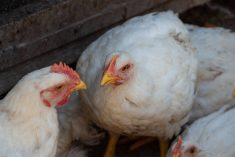A new website by the University of Bristol in the UK has been launched to help make sure laying hens stay well-feathered.
Aimed principally at free-range systems, the website also emphasizes the importance of providing good access to a quality pasture with cover to maximize the opportunities for hens to forage while feeling secure.
The website was endorsed by the poultry industry, said a university release. It focuses on management strategies to help prevent pecking damage occurring from day old chicks through rear onto transfer to the laying house and throughout lay and provides photographic examples, links and further information.
Read Also

U.S. livestock: Hogs, cattle fall
Chicago Mercantile Exchange livestock futures fell across the board on Wednesday. Most-active February live cattle futures closed at 229.550 cents…
All forms of injurious pecking, including gentle and severe feather pecking, vent pecking and cannibalism are described. In addition, there is a forum where farmers can share their experiences in managing flocks.
“When it comes to abnormal pecking behaviour, most farmers are well aware that prevention is easier than cure,” Claire Weeks, senior research fellow in animal welfare at the School of Veterinary Sciences, said in the release. “A trial of the advice in the management package on 100 farms as part of the Bristol Pecking Project found that using as many management strategies together as possible was the most effective way of achieving a fully-feathered flock.”
The Bristol team is currently trialling the advice in the management package on 20 commercial flocks where the birds have intact beaks (i.e. are not beak-trimmed) to provide information for the UK government’s review in 2015 ahead of the proposed ban from 2016.














